Neel Guha
Cartridges: Lightweight and general-purpose long context representations via self-study
Jun 06, 2025Abstract:Large language models are often used to answer queries grounded in large text corpora (e.g. codebases, legal documents, or chat histories) by placing the entire corpus in the context window and leveraging in-context learning (ICL). Although current models support contexts of 100K-1M tokens, this setup is costly to serve because the memory consumption of the KV cache scales with input length. We explore an alternative: training a smaller KV cache offline on each corpus. At inference time, we load this trained KV cache, which we call a Cartridge, and decode a response. Critically, the cost of training a Cartridge can be amortized across all the queries referencing the same corpus. However, we find that the naive approach of training the Cartridge with next-token prediction on the corpus is not competitive with ICL. Instead, we propose self-study, a training recipe in which we generate synthetic conversations about the corpus and train the Cartridge with a context-distillation objective. We find that Cartridges trained with self-study replicate the functionality of ICL, while being significantly cheaper to serve. On challenging long-context benchmarks, Cartridges trained with self-study match ICL performance while using 38.6x less memory and enabling 26.4x higher throughput. Self-study also extends the model's effective context length (e.g. from 128k to 484k tokens on MTOB) and surprisingly, leads to Cartridges that can be composed at inference time without retraining.
A Reasoning-Focused Legal Retrieval Benchmark
May 06, 2025Abstract:As the legal community increasingly examines the use of large language models (LLMs) for various legal applications, legal AI developers have turned to retrieval-augmented LLMs ("RAG" systems) to improve system performance and robustness. An obstacle to the development of specialized RAG systems is the lack of realistic legal RAG benchmarks which capture the complexity of both legal retrieval and downstream legal question-answering. To address this, we introduce two novel legal RAG benchmarks: Bar Exam QA and Housing Statute QA. Our tasks correspond to real-world legal research tasks, and were produced through annotation processes which resemble legal research. We describe the construction of these benchmarks and the performance of existing retriever pipelines. Our results suggest that legal RAG remains a challenging application, thus motivating future research.
Stronger Than You Think: Benchmarking Weak Supervision on Realistic Tasks
Jan 13, 2025Abstract:Weak supervision (WS) is a popular approach for label-efficient learning, leveraging diverse sources of noisy but inexpensive weak labels to automatically annotate training data. Despite its wide usage, WS and its practical value are challenging to benchmark due to the many knobs in its setup, including: data sources, labeling functions (LFs), aggregation techniques (called label models), and end model pipelines. Existing evaluation suites tend to be limited, focusing on particular components or specialized use cases. Moreover, they often involve simplistic benchmark tasks or de-facto LF sets that are suboptimally written, producing insights that may not generalize to real-world settings. We address these limitations by introducing a new benchmark, BOXWRENCH, designed to more accurately reflect real-world usages of WS. This benchmark features tasks with (1) higher class cardinality and imbalance, (2) notable domain expertise requirements, and (3) multilingual variations across parallel corpora. For all tasks, LFs are written using a careful procedure aimed at mimicking real-world settings. In contrast to existing WS benchmarks, we show that supervised learning requires substantial amounts (1000+) of labeled examples to match WS in many settings.
Smoothie: Label Free Language Model Routing
Dec 06, 2024



Abstract:Large language models (LLMs) are increasingly used in applications where LLM inputs may span many different tasks. Recent work has found that the choice of LLM is consequential, and different LLMs may be good for different input samples. Prior approaches have thus explored how engineers might select an LLM to use for each sample (i.e. routing). While existing routing methods mostly require training auxiliary models on human-annotated data, our work explores whether it is possible to perform unsupervised routing. We propose Smoothie, a weak supervision-inspired routing approach that requires no labeled data. Given a set of outputs from different LLMs, Smoothie constructs a latent variable graphical model over embedding representations of observable LLM outputs and unknown "true" outputs. Using this graphical model, we estimate sample-dependent quality scores for each LLM, and route each sample to the LLM with the highest corresponding score. We find that Smoothie's LLM quality-scores correlate with ground-truth model quality (correctly identifying the optimal model on 9/14 tasks), and that Smoothie outperforms baselines for routing by up to 10 points accuracy.
Prospector Heads: Generalized Feature Attribution for Large Models & Data
Feb 18, 2024Abstract:Feature attribution, the ability to localize regions of the input data that are relevant for classification, is an important capability for machine learning models in scientific and biomedical domains. Current methods for feature attribution, which rely on "explaining" the predictions of end-to-end classifiers, suffer from imprecise feature localization and are inadequate for use with small sample sizes and high-dimensional datasets due to computational challenges. We introduce prospector heads, an efficient and interpretable alternative to explanation-based methods for feature attribution that can be applied to any encoder and any data modality. Prospector heads generalize across modalities through experiments on sequences (text), images (pathology), and graphs (protein structures), outperforming baseline attribution methods by up to 49 points in mean localization AUPRC. We also demonstrate how prospector heads enable improved interpretation and discovery of class-specific patterns in the input data. Through their high performance, flexibility, and generalizability, prospectors provide a framework for improving trust and transparency for machine learning models in complex domains.
Benchmarking and Building Long-Context Retrieval Models with LoCo and M2-BERT
Feb 14, 2024Abstract:Retrieval pipelines-an integral component of many machine learning systems-perform poorly in domains where documents are long (e.g., 10K tokens or more) and where identifying the relevant document requires synthesizing information across the entire text. Developing long-context retrieval encoders suitable for these domains raises three challenges: (1) how to evaluate long-context retrieval performance, (2) how to pretrain a base language model to represent both short contexts (corresponding to queries) and long contexts (corresponding to documents), and (3) how to fine-tune this model for retrieval under the batch size limitations imposed by GPU memory constraints. To address these challenges, we first introduce LoCoV1, a novel 12 task benchmark constructed to measure long-context retrieval where chunking is not possible or not effective. We next present the M2-BERT retrieval encoder, an 80M parameter state-space encoder model built from the Monarch Mixer architecture, capable of scaling to documents up to 32K tokens long. We describe a pretraining data mixture which allows this encoder to process both short and long context sequences, and a finetuning approach that adapts this base model to retrieval with only single-sample batches. Finally, we validate the M2-BERT retrieval encoder on LoCoV1, finding that it outperforms competitive Transformer-based models by at least 23.3 points, despite containing upwards of 90x fewer parameters.
LegalBench: A Collaboratively Built Benchmark for Measuring Legal Reasoning in Large Language Models
Aug 20, 2023
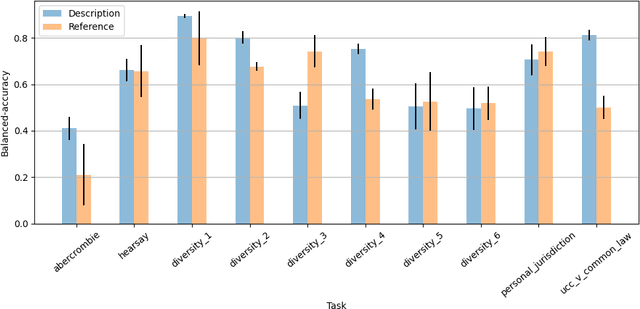
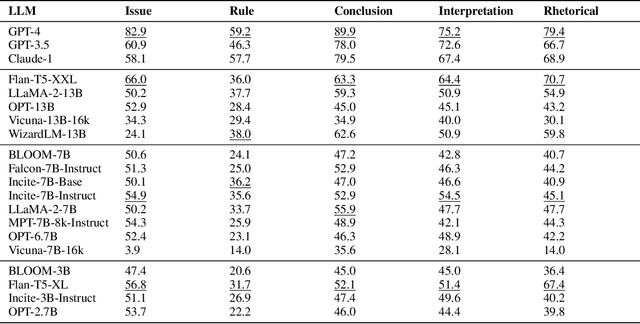
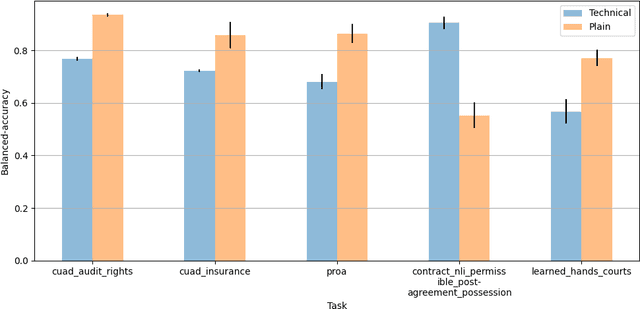
Abstract:The advent of large language models (LLMs) and their adoption by the legal community has given rise to the question: what types of legal reasoning can LLMs perform? To enable greater study of this question, we present LegalBench: a collaboratively constructed legal reasoning benchmark consisting of 162 tasks covering six different types of legal reasoning. LegalBench was built through an interdisciplinary process, in which we collected tasks designed and hand-crafted by legal professionals. Because these subject matter experts took a leading role in construction, tasks either measure legal reasoning capabilities that are practically useful, or measure reasoning skills that lawyers find interesting. To enable cross-disciplinary conversations about LLMs in the law, we additionally show how popular legal frameworks for describing legal reasoning -- which distinguish between its many forms -- correspond to LegalBench tasks, thus giving lawyers and LLM developers a common vocabulary. This paper describes LegalBench, presents an empirical evaluation of 20 open-source and commercial LLMs, and illustrates the types of research explorations LegalBench enables.
Embroid: Unsupervised Prediction Smoothing Can Improve Few-Shot Classification
Jul 20, 2023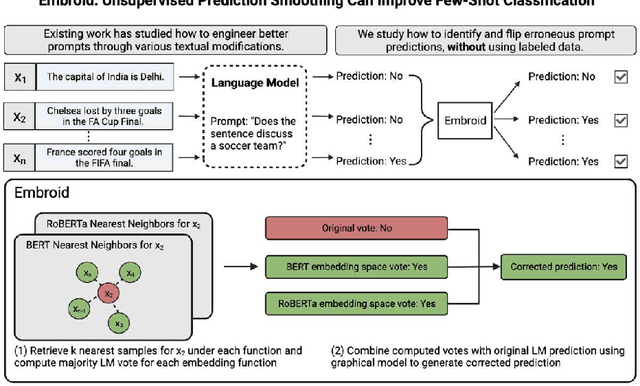


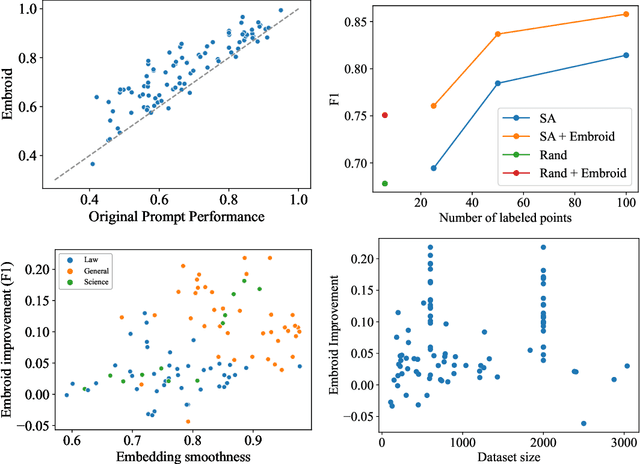
Abstract:Recent work has shown that language models' (LMs) prompt-based learning capabilities make them well suited for automating data labeling in domains where manual annotation is expensive. The challenge is that while writing an initial prompt is cheap, improving a prompt is costly -- practitioners often require significant labeled data in order to evaluate the impact of prompt modifications. Our work asks whether it is possible to improve prompt-based learning without additional labeled data. We approach this problem by attempting to modify the predictions of a prompt, rather than the prompt itself. Our intuition is that accurate predictions should also be consistent: samples which are similar under some feature representation should receive the same prompt prediction. We propose Embroid, a method which computes multiple representations of a dataset under different embedding functions, and uses the consistency between the LM predictions for neighboring samples to identify mispredictions. Embroid then uses these neighborhoods to create additional predictions for each sample, and combines these predictions with a simple latent variable graphical model in order to generate a final corrected prediction. In addition to providing a theoretical analysis of Embroid, we conduct a rigorous empirical evaluation across six different LMs and up to 95 different tasks. We find that (1) Embroid substantially improves performance over original prompts (e.g., by an average of 7.3 points on GPT-JT), (2) also realizes improvements for more sophisticated prompting strategies (e.g., chain-of-thought), and (3) can be specialized to domains like law through the embedding functions.
Holistic Evaluation of Language Models
Nov 16, 2022



Abstract:Language models (LMs) are becoming the foundation for almost all major language technologies, but their capabilities, limitations, and risks are not well understood. We present Holistic Evaluation of Language Models (HELM) to improve the transparency of language models. First, we taxonomize the vast space of potential scenarios (i.e. use cases) and metrics (i.e. desiderata) that are of interest for LMs. Then we select a broad subset based on coverage and feasibility, noting what's missing or underrepresented (e.g. question answering for neglected English dialects, metrics for trustworthiness). Second, we adopt a multi-metric approach: We measure 7 metrics (accuracy, calibration, robustness, fairness, bias, toxicity, and efficiency) for each of 16 core scenarios when possible (87.5% of the time). This ensures metrics beyond accuracy don't fall to the wayside, and that trade-offs are clearly exposed. We also perform 7 targeted evaluations, based on 26 targeted scenarios, to analyze specific aspects (e.g. reasoning, disinformation). Third, we conduct a large-scale evaluation of 30 prominent language models (spanning open, limited-access, and closed models) on all 42 scenarios, 21 of which were not previously used in mainstream LM evaluation. Prior to HELM, models on average were evaluated on just 17.9% of the core HELM scenarios, with some prominent models not sharing a single scenario in common. We improve this to 96.0%: now all 30 models have been densely benchmarked on the same core scenarios and metrics under standardized conditions. Our evaluation surfaces 25 top-level findings. For full transparency, we release all raw model prompts and completions publicly for further analysis, as well as a general modular toolkit. We intend for HELM to be a living benchmark for the community, continuously updated with new scenarios, metrics, and models.
Ask Me Anything: A simple strategy for prompting language models
Oct 06, 2022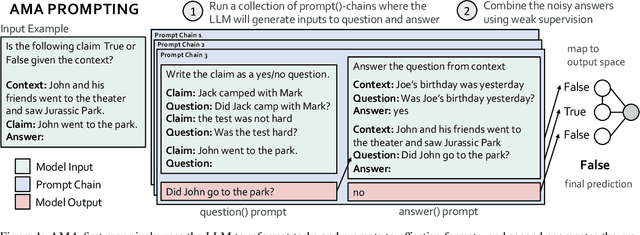
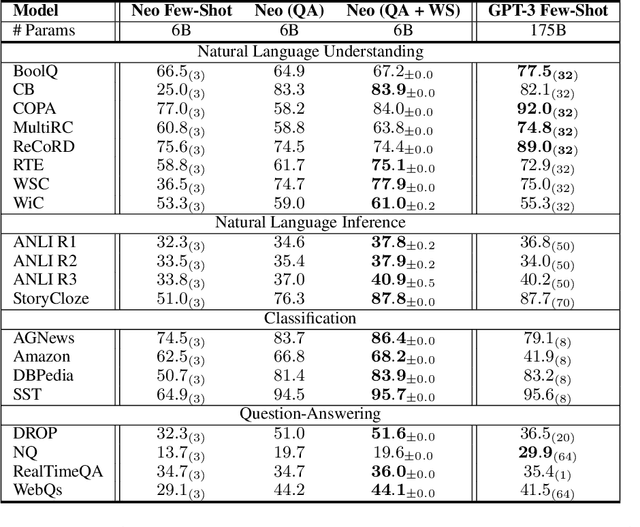


Abstract:Large language models (LLMs) transfer well to new tasks out-of-the-box simply given a natural language prompt that demonstrates how to perform the task and no additional training. Prompting is a brittle process wherein small modifications to the prompt can cause large variations in the model predictions, and therefore significant effort is dedicated towards designing a painstakingly "perfect prompt" for a task. To mitigate the high degree of effort involved in prompt-design, we instead ask whether producing multiple effective, yet imperfect, prompts and aggregating them can lead to a high quality prompting strategy. Our observations motivate our proposed prompting method, ASK ME ANYTHING (AMA). We first develop an understanding of the effective prompt formats, finding that question-answering (QA) prompts, which encourage open-ended generation ("Who went to the park?") tend to outperform those that restrict the model outputs ("John went to the park. Output True or False."). Our approach recursively uses the LLM itself to transform task inputs to the effective QA format. We apply the collected prompts to obtain several noisy votes for the input's true label. We find that the prompts can have very different accuracies and complex dependencies and thus propose to use weak supervision, a procedure for combining the noisy predictions, to produce the final predictions for the inputs. We evaluate AMA across open-source model families (e.g., EleutherAI, BLOOM, OPT, and T0) and model sizes (125M-175B parameters), demonstrating an average performance lift of 10.2% over the few-shot baseline. This simple strategy enables the open-source GPT-J-6B model to match and exceed the performance of few-shot GPT3-175B on 15 of 20 popular benchmarks. Averaged across these tasks, the GPT-Neo-6B model outperforms few-shot GPT3-175B. We release our code here: https://github.com/HazyResearch/ama_prompting
 Add to Chrome
Add to Chrome Add to Firefox
Add to Firefox Add to Edge
Add to Edge